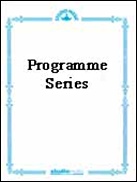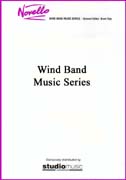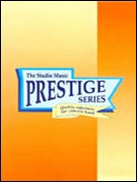Results
-
 £49.95
£49.95ELVIRA MADIGAN THEME (Programme Concert Band) - Mozart, Wolfgang Amadeus - Newton, Rodney
The 1967 Swedish film Elvira Madigan tells a true, sad story of nineteenth century love. One of the endearing characteristics of this movie was the use of the Andante from Mozart's Piano Concerto No. 21 in C major. This beautiful melody is now inseparable from this film and is loved by audiences everywhere.
Estimated dispatch 7-14 working days
-
 £44.55
£44.55Equinox
Take a good look at this superior new overture for mid-level bands by Ed Huckeby. A brief andante introduction drives straight into an animated allegro, punctuated by heart-stirring rhythms. Excellent teaching material for developing musicianship in your young players. You can't go wrong with this one - a clear winner from one of the most popular composers.
Estimated dispatch 7-14 working days
-
 £64.35
£64.35Fall River Overture
A fine overture full of beautiful sonorities that attainable by mid-level bands. The lively opening theme and expressive andante section are a winning combination that make this quality composition for concert or competition performances. One of Mr. Sheldons finest!
Estimated dispatch 7-14 working days
-
 £18.95
£18.95FOUR WELSH DANCES (Novello Symphonic Band) Extra Score - Arnold, Malcolm - Parkes, Peter
Extra Score only. Op.138a. Includes: Allegro; Poco Lento; Vivace; Andante con moto. Duration: 10 mins.
Estimated dispatch 7-14 working days
-
 £94.95
£94.95FOUR WELSH DANCES (Novello Symphonic) - Arnold, Malcolm - Parkes, Peter
Score & Parts. Opus 138A. 1. Allegro. 2. Poco Lento. 3. Vivace. 4. Andante con Moto
Estimated dispatch 7-14 working days
-
 £71.28
£71.28Heroic Sketches
Bold and dynamic, this uplifting Ed Huckeby composition is a impressive concert or festival selection that will allow your group to display its talents with playable challenges for every section of the band. Includes an eloquent andante section which features very effective solo passages for a number of the woodwind players. Driving rhythms, mixed meters, memorable melodies and dazzling percussion all combine to make this an outstanding choice for better bands. VERY HIGHLY RECOMMENDED!
Estimated dispatch 7-14 working days
-
 £104.99
£104.99Jubilant Prelude Wind Band Set (Score & Parts)
Jubilant Prelude' is an orchestration of the 'Preludium over Psalm 150' originally composed for organ by Toon Hagen. Since 1998 Toon Hagen has been organ-player of the 'Grote or Sint Micha?lskerk' in Zwolle (the Netherlands). He has written several 'contemporary' compositions for organ.'Jubilant Prelude' has a capricious character by the use of irregular measures and its many measure changes. The structure of the Prelude is that of a fugue and is based on motives from the psalm.After the first climax, which is both dynamic and harmonic, the theme in the Andante Jubiloso is clearly audible and it is alternated with erratic motifs. Tension increases until at last the psalm itself is heard in all its glory. The melody of the psalm sounds as a cantus firmus in tenor register, with motifs in ornamentation for saxophones, bugles and trumpets. The finale, like the prelude is capricious and vehement.The instrumentation for concert band was made by Wim Rouw. It is particularly colourful and has a surprising role for the percussion section. 04:30
Estimated dispatch 7-14 working days
-
 £119.95
£119.95LINDISFARNE RHAPSODY, A (Flute Solo)(Prestige Concert Band) - Sparke, Philip
Commissioned by Kenneth Bell, principal flute of the Central Band of the Royal Air Force, this delightful work is challenging but approachable and the perfect vehicle for your star flautist! (Grade 5) Performance time 13'31". "Good flautists will find this a good piece to add to their repertoires, as it presents different challenges to the standard solo fare. The solo line is particularly well set against the band as it rarely travels to the lower register of the flute. The work opens with an extended section of lyricism followed by skittish dance. The central ''andante con moto'' is particularly delicate before the final section heads off and ends in a thoroughly unexpected conclusion!" Winds Magazine (Recorded on QPRM129D VENETIAN SPELLS, Central Band of the Royal Air Force)
Estimated dispatch 7-14 working days
-
 £23.95
£23.95LINDISFARNE RHAPSODY, A (Flute/Prestige Concert Band Extra Score) - Sparke, Philip
Extra Score. Commissioned by Kenneth Bell, principal flute of the Central Band of the Royal Air Force, this delightful work is challenging but approachable and the perfect vehicle for your star flautist! (Grade 5) Performance time 13'31". "Good flautists will find this a good piece to add to their repertoires, as it presents different challenges to the standard solo fare. The solo line is particularly well set against the band as it rarely travels to the lower register of the flute. The work opens with an extended section of lyricism followed by skittish dance. The central ''andante con moto'' is particularly delicate before the final section heads off and ends in a thoroughly unexpected conclusion!" Winds Magazine (Recorded on QPRM129D VENETIAN SPELLS, Central Band of the Royal Air Force)
Estimated dispatch 7-14 working days
-
 £64.35
£64.35March Kings (Concert Band - Score and Parts)
A brilliant piece for contest or concert featuring four distinct moods. The opening section features flowing melodies supported by a gentle accompaniment in several tempos. A legato and reverent andante section follows and creates the opportunity for beautiful, expressive interpretation. The third mood is a jubilant celebration that leads to a majestic conclusion.
Estimated dispatch 7-14 working days
